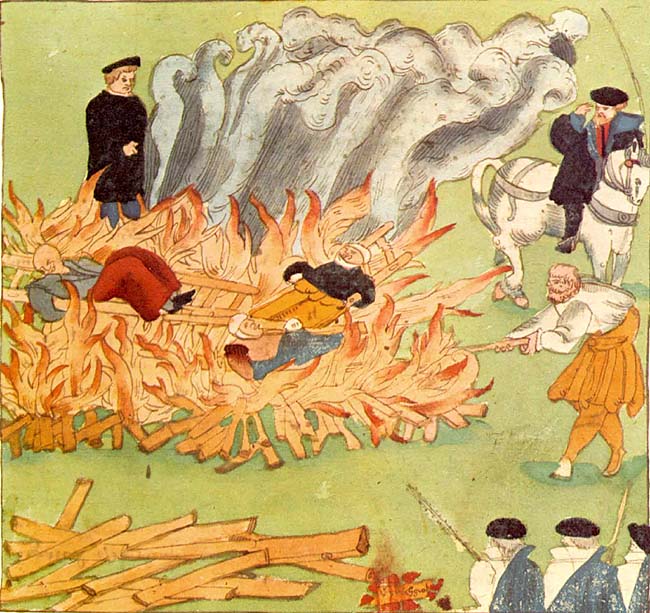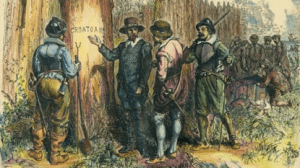In today’s world, when someone thinks of a witch, they normally picture one of a few things: the infamous Wicked Witch of the West that was out to get our beloved Dorothy; Bette Midler’s crazy looking character in Hocus Pocus; or a sparkly, purple and black ‘Party City’ outfit that young girls wear as a sort of ‘right of passage’ Halloween costume. Some may even think back to their high school history lessons about the Salem Witch Trials during the late 1600’s in colonial America. These images, however, are drastically different from those a 15th-century European would have pictured. They would have conjured up the image of a woman who wasn’t religious, who went against social norms, who had supernatural powers, and who therefore was most definitely associated with the devil.1 These Europeans would have pictured the faces of the many women accused and killed in the witch hunts of the time that were in large part driven by skewed societal perceptions, religious fears, and hysteria.
The witch hunts in Europe occurred on a much larger scale than those that took place in Salem Village. Records suggest that the hunts began as early as the 14th century and went on until around 1650, gaining the most momentum during the late 15th century. In total, the executions of supposed witches by Europeans numbered between 200,000 and 500,000, with 85% or more of those accused of and executed for witchcraft being women.2 Additionally, around 95% were specifically poor, old, single, or widowed women.3 Based on social perceptions of the time, these numbers, quite frankly, are not surprising. It is said that “heresy evidence, a major element during the dominance of the European witch craze, was that Satan recruited servants, mostly women, by signing a pact with them and turned them into his sexual subordinates.”4 It was understood by society members that these women who made such a pact with the devil were “female witches [given] the opportunity to commit evil deeds,” and that as a result of their pact and evil-doings, “[their] souls…belonged to the devil, and these women would serve in hell upon their death.”5 Society members also understood that single, elderly, poor, and/or widowed women were outcasts, and in some cases were even thought to be living sinful lives. The perception of all women as impressionable, and the perception of certain types of women who were generally unaccepted, contributed largely to the witch craze in Europe.
Perhaps the biggest factor that fueled the witch hunts of the time, however, stemmed from the religious conflicts of the age. Fifteenth-century Europeans were extremely devout Christians, and often viewed anything different as a threat to their religion. A common belief among many was that certain people possessed supernatural powers, and at the end of the fifteenth century, pronouncements from the era’s theologians began to circulate. They suggested that those who possessed diabolical powers were witches and drew their abilities straight from the devil himself.6 These beliefs were intricate, and included details about supposed witches flying to foreign places on broomsticks to attend a witch’s Sabbath, worship the devil, create special potions, and even engage in sexual relations with the devil.7 As a result of these beliefs, assumptions and rumors began to spread, mostly whenever something unexpected or inexplicable happened, that the event had been caused by a witch. These bad events ranged from crop failures to a woman’s inability to conceive.8 Given this extreme characterization, it becomes evident that Europeans of the time took witches, their powers, and their relationships with the devil very seriously. But why? What led to the widespread fear, accusations, and killings of witches in Europe?

As mentioned earlier, Europeans did not take their religious beliefs lightly, and any threats to Christianity were treated with utmost scrutiny. Additionally, because the religious wars between Catholics and Protestants occurred during the same time at which the witch hunts peaked, nothing was more concerning to a European Christian than someone who threatened their form of Christianity. British historian Norman Cohn summed up the need for Europeans to find and kill witches as “the need to create a scapegoat for an unacknowledged hostility to Christianity.”9 In this context, it may be understood that Europeans of the time were influenced–probably by the religious wars that were happening in their homelands at the time–into believing that these conflicts were a result of witches and their relationships with the devil. Other common religious beliefs that helped to fuel the fear and persecution of supposed witches included the “religious-driven conception of the relationship between demonology and witchcraft,” which elicited a belief “that the world served as a battlefield upon which an ongoing struggle between Satan and God was portrayed.”10 In a society where such a common–and detailed–belief regarding the continuous war between God and the devil was prevalent, it makes sense that rumors of witches would cause fear enough to spark the type of witch hunts that took place in Europe between the fourteenth and sixteenth centuries. Furthermore, the witch hunts took place during the heat of both the Protestant Reformation and the Catholic Counter-Reformation; therefore, those who followed the Protestant or Catholic faiths were primary targets.11
It is said that Protestant authorities who searched for and prosecuted witches acted more harshly than did authorities of the infamous Spanish Inquisition.12 Catholic witch hunting leaders also went out of their way to condemn witches by publishing the Malleus Maleficarum in 1487; this document made “demonology a severe offense punishable by religious and subsequently secular authorities.”13
For these reasons, the witch hunts were widespread throughout Europe and lasted for over 200 years. Although widespread across all of continental Europe, they were generally concentrated in areas where Catholics and Protestants lived in close proximity to each other. In most cases between the fourteenth and sixteenth centuries, the hunts occurred in waves. Catholic lands in Germany were hit with a wave in the 1560s and 1570s, and again in the 1610s and 1620s; large waves occurred simultaneously throughout small communities within the Holy Roman Empire.14 Protestant lands affected the most were Scotland and the Swiss territory of Vaud, conducting nearly 3,000 executions combined.15 Those accused of witchcraft were made to stand trial and were, more times than not, found guilty and executed by hanging or burning.16 In some cases, accused witches were even tortured and forced into making confessions.17

As with other targeted mass killings throughout history, it can be noted that the European witch hunts that took place between the fourteenth and seventeenth centuries were largely influenced by several social and political factors. Most evident are the religious views, opinions, and hostilities that existed among European communities and peoples at the time. Furthermore, the fact that a majority of those witches accused and executed were women who were viewed as being outside societal norms suggests that they were persecuted for reasons of social standards and class influence. Overall, this dark period in European history was clouded with judgement, fear, and religion-fueled wars that–in one way or another–led to the execution of hundreds and thousands of supposed witches. Whether or not the executed were actually witches, we may never know. One thing that is almost certain, however, is that the lesson of redefining moral boundaries that should have been learned from the European witch hunts, instead went unnoticed, allowing similar persecutions to occur in the New World less than fifty years later.18
- Jerry H. Bentley, Herbert F. Ziegler, and Heather E. Streets-Salter, Traditions & Encounters: A Brief Global History from 1500 to the Present, Fourth, Vol. 2 (New York: McGraw-Hill Education, 2016), 376. ↵
- Nachman Ben-Yehuda, “The European Witch Craze of the 14th to 17th Centuries: A Sociologist’s Perspective,” American Journal of Sociology 86, no. 1 (1980): 1. ↵
- Jerry H. Bentley, Herbert F. Ziegler, and Heather E. Streets-Salter, Traditions & Encounters: A Brief Global History from 1500 to the Present, Fourth, Vol. 2 (New York: McGraw-Hill Education, 2016), 376. ↵
- Nachman Ben-Yehuda, “Witches,” in Encyclopedia of Death & the Human Experience, edited by Clifton D. Bryant and Dennis L. Peck, Vol. 2 (Thousand Oaks, CA: SAGE Publications, 2009), 996. ↵
- Nachman Ben-Yehuda, “Witches,” in Encyclopedia of Death & the Human Experience, edited by Clifton D. Bryant and Dennis L. Peck, Vol. 2, (Thousand Oaks, CA: SAGE Publications, 2009), 996. ↵
- Jerry H. Bentley, Herbert F. Ziegler, and Heather E. Streets-Salter, Traditions & Encounters: A Brief Global History from 1500 to the Present, Fourth, Vol. 2 (New York: McGraw-Hill Education, 2016), 376. ↵
- Jerry H. Bentley, Herbert F. Ziegler, and Heather E. Streets-Salter, Traditions & Encounters: A Brief Global History from 1500 to the Present, Fourth, Vol. 2 (New York: McGraw-Hill Education, 2016), 376. ↵
- Jerry H. Bentley, Herbert F. Ziegler, and Heather E. Streets-Salter, Traditions & Encounters: A Brief Global History from 1500 to the Present, Fourth, Vol. 2 (New York: McGraw-Hill Education, 2016), 376. ↵
- Madeleine Jeay, “French ‘Witches’ (14th–16th Centuries),” in Women in World History: A Biographical Encyclopedia, ed., Anne Commire (Detroit: Yorkin Publications, 2002), 774. ↵
- Nachman Ben-Yehuda, “Witches,” in Encyclopedia of Death & the Human Experience, eds. Clifton D. Bryant and Dennis L. Peck, Vol. 2 (Thousand Oaks, CA: SAGE Publications, 2009), 996. ↵
- Alfred J. Andrea, and Carolyn Neel, eds., “Witch-Hunting in Western Europe: Trial by Ordeal–Witch-Hunts and Methods of Extracting Confessions,” World History Encyclopedia (Santa Barabara, CA: ABC-CLIO, 2011), 880. ↵
- Alfred J. Andrea, and Carolyn Neel, eds., “Witch-Hunting in Western Europe: Trial by Ordeal–Witch-Hunts and Methods of Extracting Confessions,” World History Encyclopedia (Santa Barabara, CA: ABC-CLIO, 2011), 880. ↵
- Alfred J. Andrea and Carolyn Neel, eds., “Witch-Hunting in Western Europe: Trial by Ordeal–Witch-Hunts and Methods of Extracting Confessions,” World History Encyclopedia (Santa Barabara, CA: ABC-CLIO, 2011), 880. ↵
- H. C. Erik Midelfort, “Witchcraft,” in Europe, 1450 to 1789: Encyclopedia of the Early Modern World, ed. Jonathan Dewald, Vol. 6 (New York: Charles Scribner’s Sons, 2004), 223. ↵
- H. C. Erik Midelfort, “Witchcraft,” in Europe, 1450 to 1789: Encyclopedia of the Early Modern World, ed. Jonathan Dewald, Vol. 6 (New York: Charles Scribner’s Sons, 2004), 223. ↵
- Jerry H. Bentley, Herbert F. Ziegler, and Heather E. Streets-Salter, Traditions & Encounters: A Brief Global History from 1500 to the Present, Fourth, Vol. 2 (New York: McGraw-Hill Education, 2016), 376. ↵
- Madeleine Jeay, “French ‘Witches’ (14th–16th Centuries),” in Women in World History: A Biographical Encyclopedia ,ed. Anne Commire (Detroit: Yorkin Publications, 2002), 774-775. ↵
- Nachman Ben-Yehuda, “The European Witch Craze of the 14th to 17th Centuries: A Sociologist’s Perspective,” American Journal of Sociology 86, no. 1 (1980): 24-25. ↵



138 comments
Todd Brauckmiller Jr.
The witch hunt era sounds very dark and depressing. What a sad time for those unfortunate women who were suspected of being a witch simply because they were single. False accusations are no joke and can really ruin someones life, in this case it always ended in death. Even the trials were rigged from the start and would just keep torturing them till they “confessed” to being a witch. Such dark times for them, may nothing like that ever happen again.
Malleigh Ebel
This article brought to light the unfairness of the witch trials and those targeted. The women who were accused were quite literally defenseless, usually having no male relatives to stick up for them. If you were an independent woman, this would be a sign of being a witch since the men were threatened by them and wanting their land. This is a sad piece of Christianity history that will be remembered for eternity.
Azucena Cuevas
Religion has always been a way for people to justify cruel events, but blaming non-believers is so extreme. The main target were women and it is sad to think that you can just be accused for not being able to have children, being a widow, or even having land. I know they targeted some people with wealth to be able to take their land as a bargain. I knew more about the Salem witches but I hadn’t known much about how it happened predominantly in Europe.
Kenneth Gilley
What an interesting article! The time period in which the European witch trials were conducted was a time of great societal tension. The split between Catholicism and Protestantism had created a great rift in the societal fabric of Europe. That tension was, in part, released through the witch hunts. It is so sad that so many vulnerable women had to suffer such cruelty and brutality.
Vania Gonzalez
Witch hunting and the trials that were faced during this time is very interesting to read about especially since it took place at a time when religion all over Europe was being challenged by reform. It is very crazy to think that witches could actually be real but at the time I guess they just really needed someone to blame but themselves and blaming a “witch” was easy because they were on the hunt for them. Also a lot of these accusations must have been out of dislike for someone in the community because that is a high number to be accusing people and killing them for really no reason. Very good article.
Cynthia Perez
Of course religion was largely valued by early century Christianity. The church had so much control over the public and it’s really sad that people had to make up rumors about these women which led to getting them killed for more reasons. This whole idea stems from how powerful beliefs are to where if they were challenged by anything remotely anti, that they would go straight to killing entire people over it. These witch trials must’ve made the century or evolution of religious diversity horrible or at least discouraging. Its also interesting how the US wasn’t alone in conducting these events.
Ariana Brown
It’s very interesting to read about witch trials that occurred outside of Salem. As Americans, Christianity plays such a huge role in our history, as pointed out in the article. Learning about other witch trials outside of the country, before America was formed, leads me to believe that as a nation we may have more to learn about the persecution of those who don’t fit the norms than what we think.
Juan Arceo
This article truly helped capture the cruel consequences that unfortunately these “witches” endured. The fact that so many people lost their lives, anywhere from 200,000 to 500,000 (85% women) mostly due to an accusation that was made against them, is unacceptable. The fact that these events weren’t just occurring in the US but also in Europe is terrifying.
Kasandra Ramirez Ferrer
We have heard about witches and what happened is were suspect to be one. I’ve heard a lot of witch stories from different parts of the world but the most interesting one is from Salem, I don’t know if witches are real or not but I do believe that people would get easily scared over any stuff or they were many religious fanatics so people would believe anything was bad and sinful. Many innocent people were killed because they were suspects of witchcraft but if you believe in God and the Devil I think some people made pacts with the Devil to serve him and hurt people.
Aaron Peters
What a well written article, I had no idea that the witch trials not only took place in the United States, but also across the Atlantic in European countries. I was surprised just how long the witch hunts went on, spanning over centuries and happening in countries as far away as modern day Germany and Scotland. It’s a shame that so many women lost their lives over ridiculously absurd accusations against them.